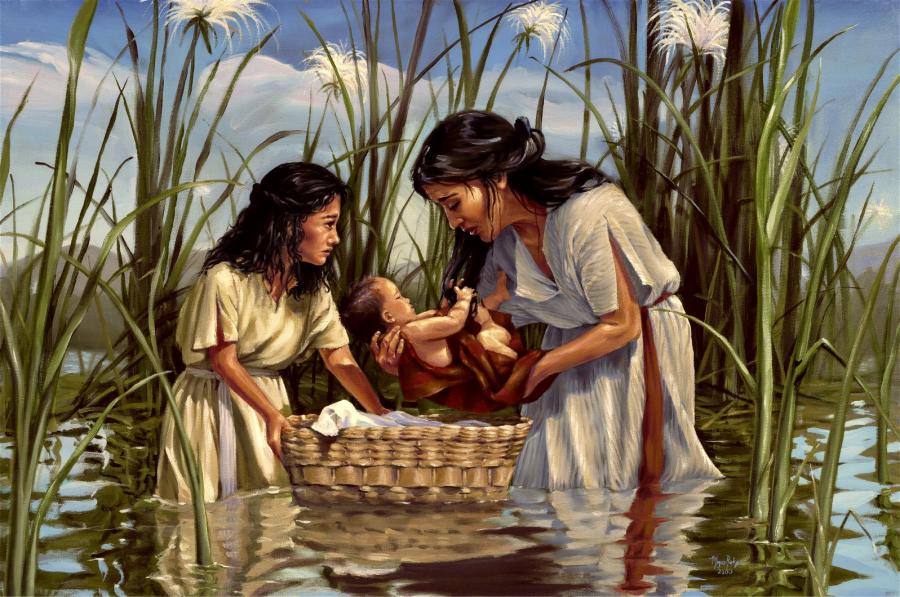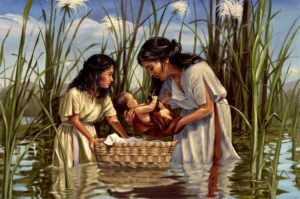Moishe’s Resume
Miriam: The Wunderkind
Welcome to the Book of Exodus and to parshas Shemois where we will meet a brand new set of Toirah personalities, heroes, characters and of course, a few villains. The first 16 chapters of Shemois deal with slavery and freedom. These amazing stories will carry us through the next four shabosim. Ober what the hec happened to the Yiddin? How did they become enslaved? And why? Just last shabbis as Yaakov was saying his final goodbyes (before dying, according to some) and doling out blessings to (most of) his children, the Yiddin were living the good life over in Goishen. They were prospering, and mistama shvindeling the goyim whenever the opportunity arose. Their brother Yoisef was the Viceroy of Mitzraym and in charge of the food granaries during the years of feast and famine. During the lean years, he sold food for cash. When their cash was depleted, he accepted barter and took their animals as payment. Thereafter, he accepted land for food and eventually the Mitzrim were left with nothing while Paroy and his treasury were enjoying huge profits. Mitzrayim became a very wealthy nation; its trade surplus more than healthy. We imagine that Yoisef mistama paid himself and his brothers healthy salaries, and as sated above, life was pretty damn good. Ober, trouble was lurking. While they were enjoying the good life, the RBSO’s master plan was about to enter its next phase. Nu, it’s one week later and all we can say is ‘eych noflu giboirim’ and ‘vey iz mir’ (how the mighty have fallen and woe is to me). Ober vus iz gisheyn (what the hec happened)? How did all this unfold so quickly? And why? Were the Yiddin being punished? Nu, to answer these questions, we must roll the heylige Toirah all the way back to parshas Lech Lecho where (Bereishis 15:12-14) the RBSO told Avrohom azoy:
| 12. Now the sun was ready to set, and a deep sleep fell upon Avrohom, and behold, a fright, a great darkness was falling upon him. | יבוַיְהִי הַשֶּׁמֶשׁ לָבוֹא וְתַרְדֵּמָה נָפְלָה עַל אַבְרָם וְהִנֵּה אֵימָה חֲשֵׁכָה גְדֹלָה נֹפֶלֶת עָלָיו: | |
| 13. And He said to Avrohom, “You shall surely know that your seed will be strangers in a land that is not theirs, and they will enslave them and oppress them, for four hundred years. | יגוַיֹּאמֶר לְאַבְרָם יָדֹעַ תֵּדַע כִּי גֵר | יִהְיֶה זַרְעֲךָ בְּאֶרֶץ לֹא לָהֶם וַעֲבָדוּם וְעִנּוּ אֹתָם אַרְבַּע מֵאוֹת שָׁנָה: | |
| 14. And also the nation that they will serve will I judge, and afterwards they will go forth with great possessions. | ידוְגַם אֶת הַגּוֹי אֲשֶׁר יַעֲבֹדוּ דָּן אָנֹכִי וְאַחֲרֵי כֵן יֵצְאוּ בִּרְכֻשׁ גָּדוֹל: |
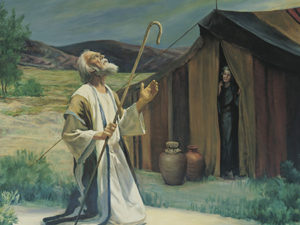 In other words: the RBSO appeared to Avrohom in a dream and told him that one day in the future, his progeny -for no apparent reason- will be strangers in a land that is not theirs. They will become enslaved for 400 years and thereafter, will leave with great wealth. Why? Ver veyst! The master plan! And guess what? The time has come. It’s all about to unfold. And what can we learn from that myseh? That the RBSO has a long memory: It’s efsher besser (better) not to anger Him!
In other words: the RBSO appeared to Avrohom in a dream and told him that one day in the future, his progeny -for no apparent reason- will be strangers in a land that is not theirs. They will become enslaved for 400 years and thereafter, will leave with great wealth. Why? Ver veyst! The master plan! And guess what? The time has come. It’s all about to unfold. And what can we learn from that myseh? That the RBSO has a long memory: It’s efsher besser (better) not to anger Him!
As Shemois opens we learn that a new king was suddenly ruling over Mitzrayim. Though the heylige Toirah tells us bifeirush (in plain English) that a new king arose, there is of course a machloikes (dispute) in the heylige Gemora as to whether or not these words are to be taken literally. One rabbi tells us that taka the old king died and a new one replaced him, while the other, suggests that it was the same old king but with new policies. He suddenly turned his back on the very Yiddin who had enriched him and his treasury. Whomever he was, the king seemingly forgot all the good done for him by Yoisef. Shoin, people forgetting favors, and or, other kindness shown to them, is sadly a minhag that many -even Yiddin- follow ad hayoim hazeh (until today).
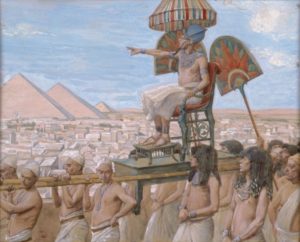 King Paroy was suddenly alarmed at the population explosion of the Yiddin. The heylige Toirah recounts that the Yiddin were multiplying; the medrish fills in the details. Says one: each pregnancy resulted in the birth of sextuplets. Impressive! Says another: each pregnancy resulted in the birth of a dozen children. OMG! And not to be outdone, says a third: sixty- count-em – yes, sixty children were born from each pregnancy. The males must have injected super sperm. Rather impressive after a full day at a construction site. Can every medrish be true? We will address that question later. Shoin! Whatever the number, fertility was not an issue. Observing the supernatural growth and rapid increase in the number of Yiddin, made the king nervous; wouldn’t most be were they to witness births by the litter coming out of humans? Said the good king: “…there are too many of them, what if they rise up against us,” we need a plan! Fearing a revolt, he issued a genocidal decree: kill all the Jewish male babies. You hear this raboyseyee? Paroy was klerring that the Yiddin were fighters. Ha! That they were going to grow up and voluntarily enlist in an army intending a takeover. Nonsense! Only a goyishe kup would think Yiddin would be planning a coup. What to do? Yiddin sue, they don’t fight!
King Paroy was suddenly alarmed at the population explosion of the Yiddin. The heylige Toirah recounts that the Yiddin were multiplying; the medrish fills in the details. Says one: each pregnancy resulted in the birth of sextuplets. Impressive! Says another: each pregnancy resulted in the birth of a dozen children. OMG! And not to be outdone, says a third: sixty- count-em – yes, sixty children were born from each pregnancy. The males must have injected super sperm. Rather impressive after a full day at a construction site. Can every medrish be true? We will address that question later. Shoin! Whatever the number, fertility was not an issue. Observing the supernatural growth and rapid increase in the number of Yiddin, made the king nervous; wouldn’t most be were they to witness births by the litter coming out of humans? Said the good king: “…there are too many of them, what if they rise up against us,” we need a plan! Fearing a revolt, he issued a genocidal decree: kill all the Jewish male babies. You hear this raboyseyee? Paroy was klerring that the Yiddin were fighters. Ha! That they were going to grow up and voluntarily enlist in an army intending a takeover. Nonsense! Only a goyishe kup would think Yiddin would be planning a coup. What to do? Yiddin sue, they don’t fight!
He forced the Yiddin to do intense back-breaking labor in order to crush their spirit and curtail their growth. The Yiddin became his salves and were forced to build two large cities, by hand mamish. Paroy chapped that the Yiddin wouldn’t enjoy manual labor. Yiddin are cut out to be executives. Of course it took them 116 years to build the cities of Peysoim and Ramsase. Why so long? Because they wouldn’t start work until after the daily daf, broke thrice daily for minyan, left early on Fridays to get ready for shabbis, and kept two days of Yom Tov though Yom Tov was yet to be decreed. Then again, was the heylige Gemora codified, but so what? In addition, they had work proscription on fast days, on isru chag, attended various dinners, emergency parlor meetings for the yeshivas in Goishen, and spent a few hours on line daily waiting to see a local Milkubil hoping to hear some good news. Sadly he would not give them assurances without a payoff. Then again, if Yaakov Ovenu observed the entire heylige Toirah -though it was yet to be given, and wouldn’t for another few hundred years- why should we assume that his eyniklich (grandchildren) didn’t follow suit?
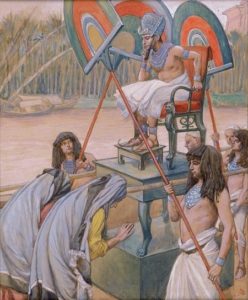 Ober Paroy was no match for the RBSO and His master plan. And mamish a few pisukim after reading of the enslavement, we read about the birth of Moishe. And to show His mastery of the world and perhaps His sense of humor, the RBSO arranged matters so that the unnamed baby would be placed into the river only to be fished out and named by Paroy’s own shiksa princess daughter whose name was either Bisya or Basya (reader’s choice). She tried nursing the crying baby. Why was Bisya down at the riverbank? Says the heylige Toirah, she went down to bathe accompanied by her handmaidens. Ober says the medrish: nonsense! She was on her way to dip into the river as part of her conversion. She wanted to become Jewish? Why? Ver veyst? Efsher the life of a princess was boring and she opted instead to join the Yiddin and try slavery. Why not? Hey, it’s medrish; anything goes. Nu, some people enjoy playing the slave/master game, if you chap. Ober how could she go to the mikveh as part of her conversion when we all know that a proper conversion must take place under the watchful eyes of three different rabbis? Nu, mamish a klutz kasha (question only an idiot would ask) because of course her conversion took place before the heylige Toirah was given, hence no need (yet) for male eye witnesses.
Ober Paroy was no match for the RBSO and His master plan. And mamish a few pisukim after reading of the enslavement, we read about the birth of Moishe. And to show His mastery of the world and perhaps His sense of humor, the RBSO arranged matters so that the unnamed baby would be placed into the river only to be fished out and named by Paroy’s own shiksa princess daughter whose name was either Bisya or Basya (reader’s choice). She tried nursing the crying baby. Why was Bisya down at the riverbank? Says the heylige Toirah, she went down to bathe accompanied by her handmaidens. Ober says the medrish: nonsense! She was on her way to dip into the river as part of her conversion. She wanted to become Jewish? Why? Ver veyst? Efsher the life of a princess was boring and she opted instead to join the Yiddin and try slavery. Why not? Hey, it’s medrish; anything goes. Nu, some people enjoy playing the slave/master game, if you chap. Ober how could she go to the mikveh as part of her conversion when we all know that a proper conversion must take place under the watchful eyes of three different rabbis? Nu, mamish a klutz kasha (question only an idiot would ask) because of course her conversion took place before the heylige Toirah was given, hence no need (yet) for male eye witnesses.
And listen to this: Says Rav Simcha Zissel Broide something even more shocking, azoy: Prior to Matan Toirah (Revelation) even the Yiddin were not considered to be Jewish. Shoin, that would avada explain how the holy shevotim married K’nanite shiksas, how Yoisef married Osnas and a whole lot more. Was anyone Jewish? Were our heylige forefathers and foremothers Jewish? Perhaps not! Anyone? Oy vey! But then he says azoy: Though not legally Jewish, they were careful to observe certain additional mitzvis (not yet given). Ober what has that to do with Bisya and her mikveh dip in connection with her conversion to Judaism? Nu, though she was Paroy’s daughter (or maybe not, as we shall soon read), and a shiksa princess, Bisya felt connected. She davka wanted to be Jewish and just to observe those certain mitzvis -though not commanded of anyone- she decided to convert, and along with that, to complete her conversion by going to the mikveh. Well blow me down! And, conversions before Matan Toirah did not require that three male rabbis witness her dunking, as this is only required for a full fledged conversion which became law only following Revelation. Nu, one cannot make this stuff up, or can one? On the other hand, it’s avada possible that a few rogue rabbis set up shop not far away and were taka peeking as she took her ritual dip. Perhaps, one had a hidden camera hooked up and was able to proclaim her dipping to be kosher (and very enjoyable). Little did Bisya know that this baby was destined for greatness. Ober the RBSO was just at the early stages of His diabolical plot. Bisya tried nursing baby Moishe, ober he refused to latch, or to suck on her bosom. Why not? Ver veyst? Enter baby Moishe’s real sister, the unnamed (until later in the Toirah) Miriam, who suggested that efsher Moishe needed a wet-nurse.
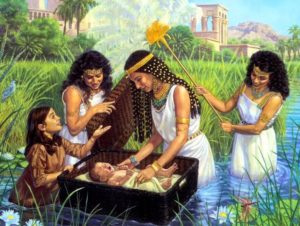 Bisya agreed. Ober, why did she instantly give up on nursing the baby and why did she accept the advice of a six year old who happened to be watching these events unfold? Perhaps she didn’t; perhaps she made a few or many attempts to nurse. Says Rashi based on the heylige Gemora (Soitah 12b which incidentally fills in much color on what took place at the river’s edge), and who knew better, azoy: Miriam suggested bringing an Ivri (Jewish) wet-nurse- because Paroy’s daughter had (after failing to nurse the baby) handed the child to ‘many’ Mitzri women to nurse, but he would not nurse from them either. You hear this? Baby Moishe was exposed to many shiksa bosoms. Rashi then explains that the baby did not want defile his mouth since he was destined to speak with the “Shichina” (Divine Presence). And what can we learn or perhaps what did other Toirah inspired entrepreneurs learn from this breast rejection myseh? That Moishe was the first Yid to be makpid (strict) on drinking only ‘cholov yisroel’ (milk produced by a Jew). Shoin, an industry was born. Efsher we can kler that the yetzer horo (inclination) to chap the bosom of a hot shiksa comes only after bar mitzvah, ver veyst.
Bisya agreed. Ober, why did she instantly give up on nursing the baby and why did she accept the advice of a six year old who happened to be watching these events unfold? Perhaps she didn’t; perhaps she made a few or many attempts to nurse. Says Rashi based on the heylige Gemora (Soitah 12b which incidentally fills in much color on what took place at the river’s edge), and who knew better, azoy: Miriam suggested bringing an Ivri (Jewish) wet-nurse- because Paroy’s daughter had (after failing to nurse the baby) handed the child to ‘many’ Mitzri women to nurse, but he would not nurse from them either. You hear this? Baby Moishe was exposed to many shiksa bosoms. Rashi then explains that the baby did not want defile his mouth since he was destined to speak with the “Shichina” (Divine Presence). And what can we learn or perhaps what did other Toirah inspired entrepreneurs learn from this breast rejection myseh? That Moishe was the first Yid to be makpid (strict) on drinking only ‘cholov yisroel’ (milk produced by a Jew). Shoin, an industry was born. Efsher we can kler that the yetzer horo (inclination) to chap the bosom of a hot shiksa comes only after bar mitzvah, ver veyst.
And taka says the Ramo (Yoreh Deah Siman 81 Sif 7): a child should not nurse from an Egyptian woman (or any other Akum (shiksa) since it brings to Timtum HaLev (stuffing up of the Jewish heart) and Teva Ra (bad tendencies), as you well know, rachmono litzlon (heaven forbid). And what’s his source for such a devastating halocha? Answer: the origin is in this week’s parsha where Moishe turned down Bisya’s and perhaps an assortment of many other bosoms. And just because you’re not Moishe Rabaynu, that does not mean or suggest, chas v’sholom (heaven forbid) that you have a free pass to stam azoy be seeking out and sucking on the bosom of a shiksa and especially many. Minuvil that you are!
Why Miriam goes unnamed until much later, ver veyst? The heylige Gemora and many a medrish will tell us that six year old (seven according to another, and a mature eleven year-old according to a third) Miriam was not only the young lady who stood by the river bank to watch over baby Moishe as he took a shtikel river cruise, but that she was also one of the midwives who helped the Yiddishe mama’s deliver anywhere from six to sixty babies at one time. Miriam is also credited for having magical marriage therapy skill and is identified by our rabbis in the heylige Gemora as being the person responsible for bringing her then -either separated or divorced- parents back together again. Such reunion resulting in her mother’s pregnancy and the subsequent birth of baby Moishe. Shoin, another time we will address yet another medrish which tells us that Yoicheved, Miriam’s mother, while divorced from her husband Amrom, married someone else and had kids. The result? Moishe had half-brothers whom we will meet later in the heylige Toirah. That for next year. How a six year old was able to accomplish these great fetes, ver veyst? Miriam was a midwife at the tender age of six? And why is that so hard to believe? Didn’t Rivka get married at three? In a few weeks, we will also learn that Miriam, by then, well into her 80’s, was also musically accomplished, and a band leader. Ober, let’s not jump ahead.
At some point, Moishe was returned by his wet-nurse (his real mother Yoicheved) to Bisya, Paroy’s real daughter. Was she? Maybe not. Seemingly, Moishe grew up in the Paroy’s palace and was mistama treated as a prince. The heylige Toirah (Shemois 2:10-11) tells us in consecutive pisukim (verses) that Moishe grew up. Let’s read them before asking a question or two.
| 10. The child grew up, and she brought him to Pharaoh’s daughter, and he became like her son. She named him Moses, and she said, “For I drew him from the water.” | יוַיִּגְדַּל הַיֶּלֶד וַתְּבִאֵהוּ לְבַת פַּרְעֹה וַיְהִי לָהּ לְבֵן וַתִּקְרָא שְׁמוֹ משֶׁה וַתֹּאמֶר כִּי מִן הַמַּיִם מְשִׁיתִהוּ: | |
| 11. Now it came to pass in those days that Moses grew up and went out to his brothers and looked at their burdens, and he saw an Egyptian man striking a Hebrew man of his brothers. | יאוַיְהִי | בַּיָּמִים הָהֵם וַיִּגְדַּל משֶׁה וַיֵּצֵא אֶל אֶחָיו וַיַּרְא בְּסִבְלֹתָם וַיַּרְא אִישׁ מִצְרִי מַכֶּה אִישׁ עִבְרִי מֵאֶחָיו: |
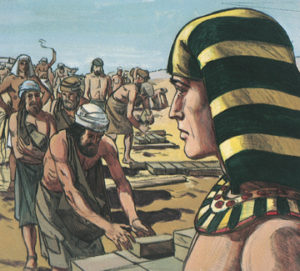 Nu, those who attended yeshiva and those who have been reading the Oisvorfer’s reviews these past seven years, know that there are no extra words in the heylige Toirah. If the Toirah repeats a word or a concept, the rabbis are all over it, they will proffer at least one reason -usually a few- as to why the heylige Toirah found it necessary to repeat that word or thought. In this case, it repeats the word ‘Vayigdal’ (and he grew up) in two consecutive pisukim. If Moishe already grew up in posik Yud (verse 10), how did he grow up again in posik Yud Aleph (11)? Moreover, how old was Moishe -not yet Rabaynu- when he grew up? Going back a few weeks, we came across the word ‘Vayigdilu’ (they grew up) when the heylige Toirah was describing Yaakov and Eisav. There, Rashi and others, told us that they turned bar mitzvah age, 13. A few weeks later, we came across Shimon and Levi. They too grew up at 13. Ober how old was Moishe? Was he too 13? Did he have a bar mitzvah in the King’s Palace? Taka a nice venue. Nu, Rashi of course took note of this duplication and tells us that its first appearance refers to his physical maturity, while the second citation of ‘Vayigdal’ is meant to convey that Moshe grew up in stature. Ober how old was he when he grew up either physically or in stature?
Nu, those who attended yeshiva and those who have been reading the Oisvorfer’s reviews these past seven years, know that there are no extra words in the heylige Toirah. If the Toirah repeats a word or a concept, the rabbis are all over it, they will proffer at least one reason -usually a few- as to why the heylige Toirah found it necessary to repeat that word or thought. In this case, it repeats the word ‘Vayigdal’ (and he grew up) in two consecutive pisukim. If Moishe already grew up in posik Yud (verse 10), how did he grow up again in posik Yud Aleph (11)? Moreover, how old was Moishe -not yet Rabaynu- when he grew up? Going back a few weeks, we came across the word ‘Vayigdilu’ (they grew up) when the heylige Toirah was describing Yaakov and Eisav. There, Rashi and others, told us that they turned bar mitzvah age, 13. A few weeks later, we came across Shimon and Levi. They too grew up at 13. Ober how old was Moishe? Was he too 13? Did he have a bar mitzvah in the King’s Palace? Taka a nice venue. Nu, Rashi of course took note of this duplication and tells us that its first appearance refers to his physical maturity, while the second citation of ‘Vayigdal’ is meant to convey that Moshe grew up in stature. Ober how old was he when he grew up either physically or in stature?
Nu, the emes is we don’t know. Why not? Because the heylige Toirah is pretty much silent regarding Moishe’s early years. The holes in Moishe’s resume are huge, very. We know only that he was born, that he left Mitzrayim in a hurry, that he returned to Mitzrayim as the RBSO’s designated redeemer-agent at 80 years of age following the encounter at the burning bush, and a week of negotiations with the RBSO. We know that he died at the ripe old age of 120. And after all that, just how old was he when he grew up and killed the Mitzri? How old was he when he arrived to Midyan and subsequently married Tziporah?
Says the Medrish (Shemois Rabbah 2:2): Moishe was not 13, he was all of 18 when he grew up, hit (killed) the Mitzri and skedaddled out of town. Another medrish tells us he was 20 when he fled Mitzrayim. Ober says Rabaynu Art Scroll that Moishe was already 40. Can both or all three be emes? Was he 18, 20 and 40? According to one chaver of the Oisvorfer, who believes that every medrish is emes, he was all of the above. How is that possible? He does not know. That however does not at all diminish his belief that every medrish is absolutely emes. Shoin, it’s good to have blind faith, or what the Oisvorfer calls, arrested development. How old was he? We don’t know. Where was he from the time he fled until his arrival to Midyan? Again, the heylige Toirah is silent, mamish. What were his accomplishments from the time he fled until his selection as the redeemer of the Yiddin? We don’t know! Nu, as the Oisvorfer told you just last week, it’s all about selection and Moishe was selected. We were not! And since he was, the heylige Gemora and many a medrish fill in the lacunas in his otherwise sparse resume. Back to him soon.
What we do know with certainty about Moishe is that he was either 18, 20 or 40 when he left Mitzrayim and was 80 when he returned. We also know that eventually he wound up in Midyan where he married Tzipoira, she the beautiful and efsher black daughter of Yisroy, he, the high priest of Midyan. A goy mamish and his daughter a shiksa. Shoin, if the shevotim were able to marry shiksas and still be called holy, why not Moishe? Veyter. Together they had two rather unremarkable children, Gershom and Eliezer, about whom we will be reading very little as we move forward. Moishe joined the family business and became a shepherd. Veyter.
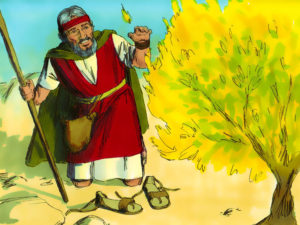 One day while tending the sheep of his shver (father-in-law), Moishe had an encounter with a burning bush, one that changed the course of his life. Nu, Moishe may have been the first to have such an encounter, ober zicher not the last, if you chap. Many who have had such encounters, do not forget them, if you chap. There, Moishe met the RBSO and spent the next seven days in negotiations over his selection.
One day while tending the sheep of his shver (father-in-law), Moishe had an encounter with a burning bush, one that changed the course of his life. Nu, Moishe may have been the first to have such an encounter, ober zicher not the last, if you chap. Many who have had such encounters, do not forget them, if you chap. There, Moishe met the RBSO and spent the next seven days in negotiations over his selection.
Shoin, with the RBSO insistent on Moishe’s mission, he had little choice but to acquiesce. His next big move was to go home and tell his wife. Moishe asks his shver (father-in-law) for permission to go, which he granted. Why he needed permission, we’ll efsher cover later. Next, he packed up his eishes chayil, his elder son Gershom and his newborn infant Eliezer and they’re on the road to Mitzrayim. Avada you can imagine that they needed to rest along the way and on the way to the inn, or at the inn, the Toirah tells us this is what happened. Hurch ois and halt kup (listen up and pay attention).
Rashi, who else, mentions the heylige Gemora (Nedarim 31B) which tells us that two angels in the form of snakes engulfed every part of Moishe’s body except his ‘mokoim mila’ (penis.) In other words: he was swallowed up, efsher a first for a Jewish husband, if you chap. His eishes chayil (wife) Tzipoirah realized that the immediate crisis was somehow connected to the ‘mokoim mila.’ But whose mila was involved and how did she chap that the mila was the culprit? Shoin, she took note that all she could now see of Moishe was his mila. Ober she knew that Moishe had been circumcised (some say he was born that way). She then chapped that the issue had to with the extra tissue of Eliezer, their younger son. Seemingly in his haste to carry out the mission, Moishe neglected to arrange a bris for his younger son Eliezer. The RBSO was seemingly upset that His own agent, was a shtikel lax in the performance of this mitzvah and sent out snakes to deliver the message. What to do? Nu, Tzipoirah took matters into her hands (and mouth), and performed the bris on Eliezer by using a sharp stone. Immediately thereafter, the snakes released Moishe unharmed. Is there any reason to read a farkakte novel when you can learn the heylige Toirah? Not!
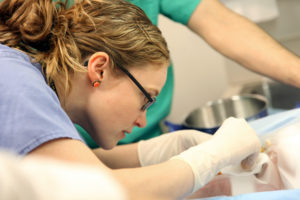
Nu, avada you’re klerring (pondering) azoy: if Tzipoirah did such good work, why don’t we see more Brissim (circumcisions) performed by women? And the sheylo (question) is: are properly trained women permitted to perform circumcisions? Grada the Oisvorfer was zoiche to attend a bris a few years back, where the cutting and the entire ceremony was performed by a woman. And it so happened that both parents of the baby were also women; such nachas from the kinder. Shoin! And wouldn’t you know, this very topic is discussed in the heylige Gemora (Avoidah Zoro 37A) where we find a machloikes between Rav and Reb Yoichonon. The Gemora tries to use the Tzipoirah incident as proof for Reb Yoichonon’s view that women are indeed able to circumcise, but Rav isn’t biting, if you chap. Says Rav: that Tzipoirah did not perform the bris on her own son. He posits that she either told someone else (presumably another Jew) to circumcise Eliezer or that she only did part of the mila, with Moishe finishing the job. Grada this theory makes perfect sense as we can all agree that mistama Tzipoirah, as a nice Jewish woman wasn’t going to perform metzitza be’peh on anyone, let alone on her own son. Ober says, Reb Yoichonon that all women are able to perform a mila, just as Tzipoirah did. Shoin! Supporting Reb Yoichonon’s view that women may in fact perform a bris are no lesser giants than the Rif, Rosh, RambaM, and the Shulchan Aruch. The Rif in particular writes, at the very end of his commentary on Perek R’ Eliezer D’Mila, that we pasken like Reb Yoichonon.
Efsher you’re wondering and taka some ask, why Moishe didn’t perform the bris, why Tzipoirah? Ober, can you just imagine the startled look on many were they to observe a female moielet performing the bris and mitzitza bipeh on stage? OMG! Nu- according to the pshat that he (Moishe) was swallowed up by the malach / snake, we need to kler and accept that it would be somewhat challenging to move about while inside the snake. And what the hec is the snake doing here in our parsha anyway? Didn’t he cause enough tzuris (problems) for mankind after seducing Chava way back in parshas Bereishis? And didn’t he learn his lesson? Didn’t the RBSO punish him severely and permanently by chopping off his legs for making the move on Chava with forbidden fruit which according to one medrish, included his own, if you chap? He did! Shoin, and with that background, let’s quickly review these few pisukim innaveynig (let’s review the text).
| 24. Now he was on the way, in an inn, that the Lord met him and sought to put him to death. | כד. וַיְהִי בַדֶּרֶךְ בַּמָּלוֹן וַיִּפְגְּשֵׁהוּ יְ־הֹוָ־ה וַיְבַקֵּשׁ הֲמִיתוֹ: | |
| 25. So Tzipporah took a sharp stone and severed her son’s foreskin and cast it to his feet, and she said, “For you are a bridegroom of blood to me.” | כה. וַתִּקַּח צִפֹּרָה צֹר וַתִּכְרֹת אֶת עָרְלַת בְּנָהּ וַתַּגַּע לְרַגְלָיו וַתֹּאמֶר כִּי חֲתַן דָּמִים אַתָּה לִי: | |
| 26. So He released him. Then she said, “A bridegroom of blood concerning the circumcision.” | כו. וַיִּרֶף מִמֶּנּוּ אָז אָמְרָה חֲתַן דָּמִים לַמּוּלֹת: |
Nu, efsher you’re a bit confused. Efsher you never got this far into the parsha before being distracted by side conversations and stam azoy gossip and jokes with your chaverim in shul. Ober this givaldige and amazing story all unfolds in shishi (sixth aliya). All you remember from the parsha is that Moishe is born and the burning bush; taka, who wouldn’t, if you chap? Nu, we can clearly see that there’s more to the heylige Toirah than this little incident (now even smaller). You must read the pisukim above and chap pshat. The family is on the way to Mitzrayim for the big meeting with Paroy. Moishe is acting on the RBSO’s command to save the Yiddin and the RBSO wants to kill him!? Since when do we kill the messenger? What the hec is going on here? What’s pshat? Forget about pshat, what do the words mean? Didn’t the RBSO just finish convincing Moishe that he’s the man for the job, and now death? Are you confused? Not to worry; you are not alone. Many of our sages and exegetes were left dumbfounded by this myseh. Let’s explore what a few suggested might have taken place and why. Select the pshat that talks to you.
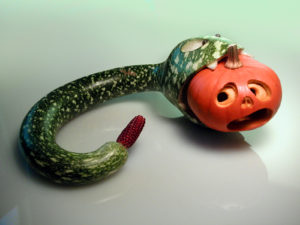 Or, do we follow a Bereyso in the heylige Gemora (Nedorim) in which Reb Yosi said: rachmono litzlon (heaven forbid)! Moishe wasn’t negligent! Moishe thought: If I circumcise him and set out on a journey, the child’s life will be in danger for three days. On the other hand, efsher I should circumcise him and wait three days, ober [but,] the RBSO has commanded me, “Go! and return to Egypt.” Then, why was he punished? Because his first concern was his lodging. Pshat could be that Moishe was wasting time arguing for an upgraded desert view room. Nu, so what happened? The angel turned into a snake and swallowed him (Moishe) from his head to his thigh [and spit him out] and then again swallowed him from his feet to that place (his penis). Is that pshat? Is that what took place? Let’s see one more.
Or, do we follow a Bereyso in the heylige Gemora (Nedorim) in which Reb Yosi said: rachmono litzlon (heaven forbid)! Moishe wasn’t negligent! Moishe thought: If I circumcise him and set out on a journey, the child’s life will be in danger for three days. On the other hand, efsher I should circumcise him and wait three days, ober [but,] the RBSO has commanded me, “Go! and return to Egypt.” Then, why was he punished? Because his first concern was his lodging. Pshat could be that Moishe was wasting time arguing for an upgraded desert view room. Nu, so what happened? The angel turned into a snake and swallowed him (Moishe) from his head to his thigh [and spit him out] and then again swallowed him from his feet to that place (his penis). Is that pshat? Is that what took place? Let’s see one more.
Says Reb Shimon ben Gamliel azoy: it was the baby whose death was sought. And some commentaries (notably Rabbenu Chananel in Yuma 85b) suggest that Tzipoirah was at fault due to her idolatrous upbringing (efsher maybe Moishe should not have married her at all); what would your father say if you brought home a Midyanite very dark looking shiksa? According to this pshat, it was the baby who the Malach swallowed feet first till his genital organ, then swallowed the child’s head first, also stopping at the organ. Beware of the one-eyed snake!. One thing they all agree on: that none of them agree on what may have taken place. What else is new? Don’t like this pshat either? Let’s try one more.
Says RambaN and Targum Yoinoson azoy: the child Tzipoirah needed to circumcise was Gershom, Moishe’s older son. Huh?? Gershom? How old was he and why wasn’t he already circumcised? Pshat here is that Yisroy made Moishe and Tzipoirah promise that they would not circumcise him as long as they lived in Midyan and as long as they were living off the in-laws, and they complied.
What can we learn from all of this? Two things. Ershtens (firstly), imaginations on real pshat ran wild and are all over the place; the Medrish is very creative. Secondly: we see that the RBSO is quite serious about the bris mila, serious enough to almost lose the central character of the entire book of Exodus. Where would we be without Moishe Rabaynu? And we also learn that when it comes to tzadikkim (truly righteous people), the RBSO is exacting to the hairsbreadth- he punishes them for their tiny misdeeds in this world so that they can enter the next world perfectly free of any taint. And that, Raboyseyee, is givaldige news for most of you giferliche bums. Seemingly you have nothing to worry about as your list of chatoim (misdeeds) is so long and over so many years, that the RBSO will (likely) not deal with you in this world, though if you’re lucky, you may get swallowed up once in a while, if you chap.
Nu, earlier we asked if Bisya was Paroy’s real daughter and hinted to another possibility. As to story goes, Bisya, by chance mamish, or efsher to complete her conversion, went down to the side of the river accompanied by a number of her shiksa maids. She noticed a baby in a basket floating, stretched out her arm and the rest is history. Ober who was Bisya? Was she but Paroy’s daughter, a shiksa princess and Moishe’s adoptive mother? Let’s find out by reviewing this most astonishing shtikel medrish based on kabolo (mysticism) and you will quickly chap why the study of kabolo is not recommended until we are at least forty years of age and well educated in the heylige Toirah and Gemora. And why not? Because kabolo can mamish blow you mind. Citing the Zoihar Hakoidesh, the midrash tells us azoy: halt kup here (pay attention) as that is not explicitly said in the Chumash- but the midrash avada has literary license and tells us this givaldige chiddish (breakthrough). Bisya- Paroy’s daughter and Tzipporah- Moishe’s wife, – have something else in common besides a relationship with this Moishe. Tzipporah and Bisya were twin sisters, sold in the market place shortly after birth and separated when two different men, Yisroy and Paroy respectively, purchased them. They have somewhat similar upbringings: Both are raised in homes of royalty (one in an Egyptian palace and the other in the home of the High Priest); both are steeped in homes and lands of Avoida zoroh (idolatry). Each, in their own way, will play significant roles in shaping and molding the man named Moishe who will lead a slave nation to freedom; to nationhood as the RBSO’s chosen people; and ultimately to the establishment of a holy kingdom settled by a holy nation of kings and priests. Their pagan backgrounds, devoid of any “yichus” of an Avrohom, Yitzchok or Yaakov, will actually serve them in their later roles in life. Having “been there, and done that”, their strength of conviction and commitment to the RBSO’s laws and the Jewish people will defy any human power on earth and outshine their peers spiritually privileged to have been born into the covenant. Well, blow me down. So much for ‘yichus’ (pedigree) as a priority. Perhaps, we should be looking for shiduchim in the Far East. And as the Oisvorfer has been known to state in the past: though many have embraced the Zohan as played by Adam Sandler in the movie, the Zohar was just as entertaining with his incredible imagination.
A gittin Shabbis-
The Oisvorfer Ruv
Yitz Grossman
